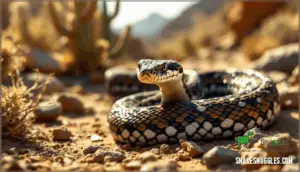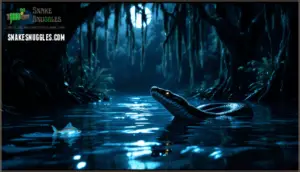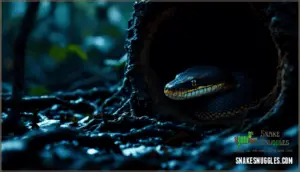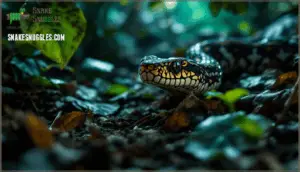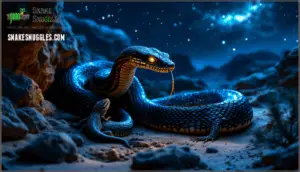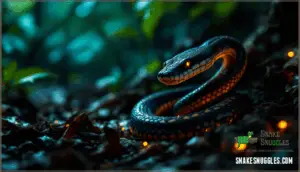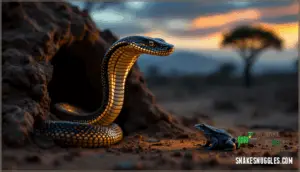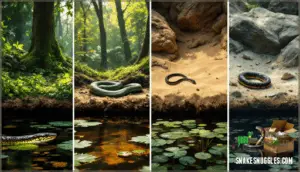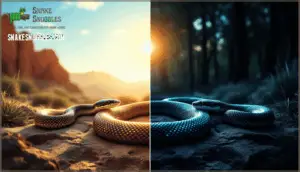This site is supported by our readers. We may earn a commission, at no cost to you, if you purchase through links.
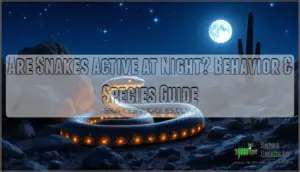 You flip on a porch light after sunset and freeze. A thick-bodied snake coils near the steps. Your mind races—did it just arrive, or has it been hunting here all evening? Most people assume snakes bask in daylight and vanish after dark. But roughly 30 to 40 percent of snake species do their serious work at night.
You flip on a porch light after sunset and freeze. A thick-bodied snake coils near the steps. Your mind races—did it just arrive, or has it been hunting here all evening? Most people assume snakes bask in daylight and vanish after dark. But roughly 30 to 40 percent of snake species do their serious work at night.
They’ve spent millions of years perfecting nocturnal hunting strategies. Heat-sensing pits let rattlesnakes track warm-blooded prey in pitch darkness. Cottonmouths wait for temperatures to drop before they start prowling. Even gaboon vipers spend their first six hours after dusk locked in ambush mode.
Understanding when and why snakes become active at night helps you avoid surprise encounters and appreciate the clever adaptations that make these reptiles such efficient nighttime predators.
Table Of Contents
- Key Takeaways
- Nocturnal Snake Behavior
- Rattlesnakes
- Cottonmouths
- Boa Constrictors
- Gaboon Vipers
- Night Snake
- Bushmaster
- Egyptian Cobra
- What Type of Habitat Do Snakes Live In?
- Are Snakes Really Nocturnal or Diurnal?
- Frequently Asked Questions (FAQs)
- Are snakes around at night?
- Are snakes nocturnal?
- Are diurnal snakes active at night?
- Why are snakes more active at night?
- Do nocturnal snakes hunt at night?
- Are rattlesnakes active at night?
- What is the difference between nocturnal and diurnal snakes?
- Are rattlesnakes more active during the day or night?
- What type of venom do bushmasters have?
- How can I tell if a snake I see is venomous or not?
- Conclusion
Key Takeaways
- Many snake species are most active at night, using cooler temperatures to hunt and avoid daytime heat.
- Heat-sensing pits help nocturnal snakes like rattlesnakes, cottonmouths, and boas track warm-blooded prey in total darkness.
- Snake activity patterns shift with temperature, prey movements, and even moon phases, making them unpredictable for outdoor explorers.
- Understanding these nighttime behaviors helps you stay safe and appreciate how snakes adapt to different habitats and conditions.
Nocturnal Snake Behavior
Why do some snakes thrive after dark? Nocturnal Snake Behavior is driven by temperature regulation and hunting strategies. Around 30–40% of snake species are nocturnal, shifting their activity to avoid daytime heat.
These snakes rely on sensory adaptations like heat-sensitive pits to detect warm-blooded prey in low light. Lunar influence matters too—prairie rattlesnakes show 70% nocturnal activity during new moons, dropping to 40% under full moons.
Predator avoidance and synchronization with nocturnally active prey also shape snake activity patterns. In urban environments, nocturnal snakes adapt to cooler nighttime conditions while hunting rodents and small mammals that emerge after sunset.
Rattlesnakes
Among nocturnal snakes, rattlesnakes show flexible activity patterns shaped by thermal regulation. During summer, when temperatures climb past 90°F, you’ll find these snakes hunting at night or during twilight hours—roughly an hour before sunrise and after sunset. Their infrared pit organs detect heat signatures from rodents in complete darkness, making them skilled nighttime predators.
In spring and fall, rattlesnakes switch to daytime activity when cooler weather allows safer movement. Adults consume rodents while juveniles target lizards near burrows.
Come winter, rattlesnake habitats include communal dens where seasonal dormancy occurs at temperatures between 43–50°F. It’s worth mentioning that rattlesnake bites often happen between April and October when outdoor activity increases. Understanding snake activity patterns helps with snakebite prevention during outdoor adventures.
Cottonmouths
Like rattlesnakes, cottonmouths adjust their activity based on temperature. You’ll encounter these nocturnal snakes hunting after sunset, especially when daytime heat exceeds 82°F. Their heat-sensing pit organs detect thermal cues from prey in total darkness—fish, frogs, and small mammals become targets along wetland edges and shallow water. Cottonmouths possess a facial pit for sensing infrared radiation.
Field studies show 73% of their hunting happens at twilight or night. They cover over a kilometer while foraging through southern swamps and marshes. When threatened after dark, cottonmouths rely less on defensive posturing and more on concealment. They retreat to aquatic hideouts where snake habitats provide both cover and temperature control.
Their nocturnal foraging peaks during warm, humid nights when snake behavior shifts toward active hunting rather than energy conservation.
Boa Constrictors
You know boa constrictors mainly hunt at night, right? They spend daylight hours tucked inside burrows or hollow logs, then come alive after sunset. Their heat-sensing pits detect temperature changes as tiny as 0.002°C, letting them track warm-blooded prey in complete darkness. This nocturnal behavior gives them access to rodents, opossums, and birds without competing with diurnal predators.
Young boas climb trees to hunt, showing arboreal behavior that shifts as they grow. Adults stick to the ground and mammal burrows instead. Snake activity drops during cooler months when their metabolism slows and prey becomes scarce. If threatened, they hiss loudly and release foul-smelling musk from tail glands.
Their habitat tolerance is impressive—you’ll find them in rainforests, woodlands, and even near farms.
Gaboon Vipers
Gaboon vipers turn the forest floor into a deadly trap after sunset. These heavyweights of the viper world become active around dusk, spending the first six hours of the night hunting rodents in open fields. Their nocturnal behavior keeps them cool and safe from daytime predators. You’ll find them most active during the rainy season from September through December, when prey is abundant and mating occurs. Their ambush predation style means they sit motionless in leaf litter for hours, waiting to deliver strikes that hit 175–200 miles per hour—faster than you can blink.
Key traits that make Gaboon vipers formidable nocturnal hunters:
- Venom potency reaches lethal levels, with each strike delivering 200–1000 mg capable of taking down antelopes
- Locomotion style relies on slow rectilinear movement, making them nearly invisible among leaves until they attack
- Habitat loss from deforestation threatens their hunting grounds, particularly in Nigeria and Togo where palm oil cultivation expands
- Conservation status remains "Least Concern" globally despite regional declines in South Africa’s coastal forests
Night Snake
The Night Snake lives up to its name by hunting after dark across western North America. You’ll find this small, venomous species from British Columbia down to Costa Rica, thriving in deserts and rocky canyons. Its nocturnal behavior peaks when temperatures hit 68–86°F, but colder nights shut down activity fast.
The snake uses rear fangs and mild venom to paralyze lizards—its favorite prey—along with eggs and baby rattlesnakes. Prey ambush tactics work perfectly at night when lizards hide.
Females lay a clutch size of 3–9 eggs in summer, with hatchlings emerging two months later. Habitat variation matters: northern populations face temperature constraints that limit hunting seasons compared to southern cousins.
Bushmaster
You’ll encounter Bushmasters deep in tropical rainforests spanning South and Central America, where these massive pit vipers hunt nocturnally. They spend daylight tucked under logs or leaf litter, then emerge after dusk when humidity peaks and temperatures moderate.
Their ambush strategy relies on infrared-sensitive pit organs that detect warm-blooded prey along animal trails. Bushmaster venom delivers a lethal cocktail—proteolytic and hemorrhagic compounds causing tissue death and cardiovascular collapse.
Females lay 5–19 eggs in abandoned rodent burrows, guarding nests for 60–79 days without eating. Bushmaster habitat loss from logging threatens these rare snakes. Bushmaster conservation efforts focus on protecting intact primary forests where populations survive.
Egyptian Cobra
Egyptian cobras prove that snake behavior varies wildly between populations. These nocturnal hunters emerge during twilight and nighttime hours across North Africa, stalking prey through scrubland and savannas. You’ll find them most active when temperatures drop and darkness provides cover.
Their activity patterns shift based on location and conditions:
- Nocturnal hunting peaks occur when toads and rodents venture out after sunset
- Crepuscular activity happens during cooler morning hours for basking and thermoregulation
- Dietary habits include toads, small mammals, birds, and eggs—swallowed whole after neurotoxic envenomation
- Geographic range spans 23 African countries from Egypt to the Congo Basin
- Captive behavior changes dramatically under artificial lighting, increasing daytime movement
Venom toxicity varies by region. Northern populations from Egypt and Tunisia pack stronger venom—averaging 175–300 mg per bite. These snake species stick close to termite mounds and burrows between hunts, returning to the same shelters night after night.
What Type of Habitat Do Snakes Live In?
Snakes don’t stick to one type of home—they’ve adapted to nearly every environment on Earth. Forest habitats house the most species, with over 27% thriving in dense vegetation where prey is abundant. You’ll find arboreal snakes like tree boas climbing canopies with prehensile tails, while terrestrial species hunt along the forest floor.
Desert snakes survive extreme heat through nocturnal behavior and burrowing. Aquatic snakes dominate wetlands and rivers, using specialized adaptations for underwater hunting. Urban snakes have learned to exploit human settlements, feeding on rodents near garbage piles and crop fields.
Snake habitat preferences depend on temperature, prey availability, and shelter options—whether that’s leaf litter, rock crevices, or abandoned burrows.
Are Snakes Really Nocturnal or Diurnal?
You can’t box snakes into just one schedule—their activity patterns shift with environmental factors and survival needs. Most species are flexible, switching between nocturnal, diurnal, and crepuscular behavior depending on temperature and prey availability.
Prairie rattlesnakes hunt at night when summer heat exceeds 35°C, while Egyptian cobras adjust their diel rhythms based on conditions.
These sensory adaptations let snakes track prey using infrared sensing and chemical cues regardless of light levels. Snake behavior follows what works best for hunting strategies and thermal regulation in their specific habitat.
Frequently Asked Questions (FAQs)
Are snakes around at night?
Regarding the shadows, the old saying holds true: "The darkest hour is just before dawn." Yes, many snakes are around at night. Nocturnal behavior helps them regulate body temperature and hunt prey effectively.
Are snakes nocturnal?
You’ll find many snakes showing nocturnal activity, especially when temperatures rise. Activity patterns shift with environmental factors and prey influence.
Some species adapt to urban spaces, weaving their nighttime behavior around seasonal shifts and available shelter.
Are diurnal snakes active at night?
Like clockwork, diurnal snakes mostly rest at night, but when Temperature Influence or Prey Availability shifts, you’ll catch them weaving into nocturnal behavior.
Mating Seasons and Habitat Encroachment can flip their activity patterns, revealing surprising nocturnal diurnalism.
Why are snakes more active at night?
Snakes are more active at night because cooler temperatures boost metabolic efficiency and hunting adaptations. Nocturnal behavior helps with predator avoidance, while sensory mechanisms like heat sensing and chemoreception make it easier to find prey in low-light conditions.
Snakes become more active at night because cooler temperatures and specialized senses make hunting and survival easier in the dark
Do nocturnal snakes hunt at night?
Nocturnal snake species hunt at night, using hunting strategies like ambush and relying on sensory adaptations such as heat-sensing pits.
Their prey selection shifts with lunar influence and seasonal activity, making nighttime hunting a key part of snake behavior.
Are rattlesnakes active at night?
Ever wonder why rattlesnakes slip out under the stars? Their circadian rhythms and sensory adaptations let them hunt nocturnally, especially when prey overlap peaks during warmer nights.
Seasonal activity patterns shift, making thermal detection key for nighttime snake behavior.
What is the difference between nocturnal and diurnal snakes?
You’ll notice nocturnal snakes hunt and feed at night, using heat-sensing pits and stealth to find prey. Diurnal species chase food during daylight, relying on sharp vision and basking for thermoregulation.
These activity patterns reflect evolutionary drivers and ecological roles.
Are rattlesnakes more active during the day or night?
Rattlesnake activity patterns shift with the seasons. You’ll see more diurnal behavior in cooler months, but as temperatures rise, rattlesnakes become nocturnal or crepuscular, using thermoregulation and hunting habits to avoid daytime heat and environmental impact.
What type of venom do bushmasters have?
Bushmasters have venom packed with enzymes—metalloproteinases, serine proteinases, and phospholipases A This mix causes strong systemic effects in prey.
While their toxicity levels aren’t the highest, the venom’s potency factors make them dangerous.
How can I tell if a snake I see is venomous or not?
Imagine every snake in the world wearing a warning sign—if only it were that easy! Venomous Identification isn’t foolproof: Head Shape, Pupil Shape, and Scale Patterns can mislead. Mimicry Tactics make snake safety tricky.
Conclusion
Like moonlit explorers, snakes slip through the shadows, mastering the art of nighttime movement. If you wonder, “Are snakes active at night?”—the answer hides in their silent, calculated steps.
Their world is built on patience, heat-sensing skill, and perfect timing. Each species follows its own rhythm, thriving where most eyes can’t see.
Understanding these patterns isn’t just about avoiding surprises; it’s about seeing nature’s genius at work, even when the lights go out.
- https://wildlife.ca.gov/Conservation/Reptiles/Rattlesnake
- https://pubmed.ncbi.nlm.nih.gov/23969850/
- https://dnr.illinois.gov/content/dam/soi/en/web/dnr/grants/documents/wpfgrantreports/2003034w.pdf
- https://peecnature.org/learn/nature-guides/featured-critters/western-diamondback-rattlesnake/
- https://www.sciencedirect.com/science/article/pii/S0003347205809571

